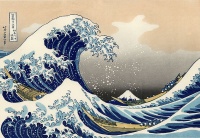Japanese art
From The Art and Popular Culture Encyclopedia
| Revision as of 12:36, 12 March 2008 Jahsonic (Talk | contribs) ← Previous diff |
Revision as of 23:04, 16 July 2009 Jahsonic (Talk | contribs) Next diff → |
||
| Line 1: | Line 1: | ||
| + | [[Image:The Great Wave off Kanagawa by Hokusai.jpg|thumb|right|200px|''[[The Great Wave off Kanagawa]]'' (between [[1823]]-[[1829|29]], [[woodblock printing in Japan|woodblock printing]] by [[Hokusai]]]] | ||
| {{Template}} | {{Template}} | ||
| '''Japanese art''' covers a wide range of art styles and media, including ancient pottery, sculpture in wood and bronze, ink painting on silk and paper, and a myriad of other types of works of art. It also has a long history, ranging from the beginnings of human habitation in [[Japan]], sometime in the 10th millennium BC, to the present. | '''Japanese art''' covers a wide range of art styles and media, including ancient pottery, sculpture in wood and bronze, ink painting on silk and paper, and a myriad of other types of works of art. It also has a long history, ranging from the beginnings of human habitation in [[Japan]], sometime in the 10th millennium BC, to the present. | ||
| Line 14: | Line 15: | ||
| *[[Ukiyo-e]] | *[[Ukiyo-e]] | ||
| *[[Japonism]] | *[[Japonism]] | ||
| + | *[[Japanese culture]] | ||
| *[[Yotsuya Simon]] | *[[Yotsuya Simon]] | ||
| {{GFDL}} | {{GFDL}} | ||
Revision as of 23:04, 16 July 2009
|
Related e |
|
Featured: |
Japanese art covers a wide range of art styles and media, including ancient pottery, sculpture in wood and bronze, ink painting on silk and paper, and a myriad of other types of works of art. It also has a long history, ranging from the beginnings of human habitation in Japan, sometime in the 10th millennium BC, to the present.
Painting is the preferred artistic expression in Japan, practiced by amateur and professional alike. Until modern times, the Japanese wrote with a brush rather than a pen, and their familiarity with brush techniques has made them particularly sensitive to the values and aesthetics of painting. With the rise of popular culture in the Edo period, a style of woodblock prints called ukiyo-e became a major artform and its techniques were fine tuned to produce colorful prints of everything from daily news to schoolbooks. The Japanese, in this period, found sculpture a much less sympathetic medium for artistic expression; most Japanese sculpture is associated with religion, and the medium's use declined with the lessening importance of traditional Buddhism.
Japanese ceramics are among the finest in the world and include the earliest known artifacts of their culture. In architecture, Japanese preferences for natural materials and an interaction of interior and exterior space are clearly expressed.
Today, Japan rivals most other modern nations in its contributions to modern art, fashion and architecture, with creations of a truly modern, global, and multi-cultural (or acultural) bent.
See also


